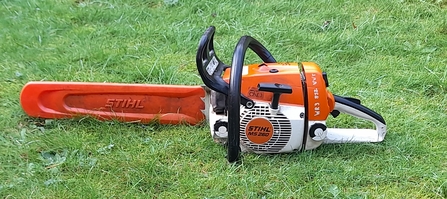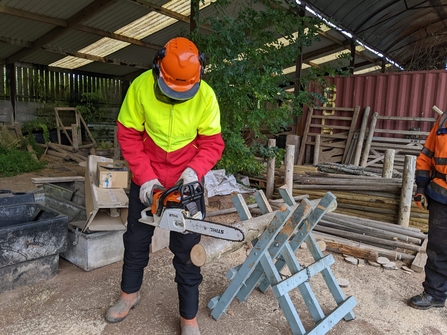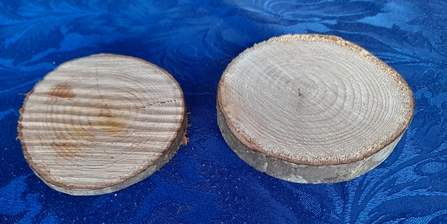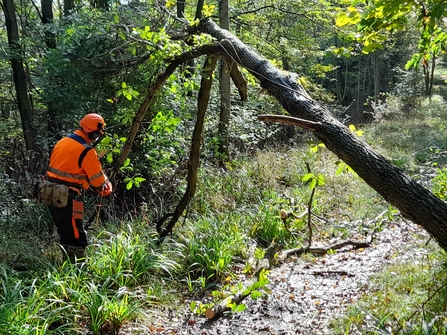
Dave the chainsaw by Patrick Taylor
Chainsaw by Lydia Rackham

Dave the chainsaw by Patrick Taylor
Introducing Dave...
Six months into my traineeship, all the other trainees and I have acquired new work buddies and this is mine. He is called Dave, he is a lot sharper than me but also potentially more destructive and needs to be treated very carefully. However, we have much in common; we have both worked on many Trust reserves, we are both a bit slow to start in the morning and are both showing some signs of a hard life. However, when properly looked after, we are both reliable, dependable and capable of a useful day's work.
You may be aware that anyone can purchase a basic chainsaw from the middle aisle of a well-known discount supermarket and set about clear-felling their garden with it. It was recently pointed out that the aforementioned supermarket sells no personal protective equipment (PPE) to go with it. At the Trust, and at every other responsible organisation, the attitude is rather different and all chainsaw users have to successfully complete one or more courses and are issued with all the required PPE before they are allowed to use a chainsaw. The qualifications are collectively known as a “chainsaw ticket” and the ticket is one of the most common requirements for a job in conservation. For this reason, chainsaw training is a major part of the traineeship. All four of us are scheduled to complete the first course “Chainsaw Maintenance and Cross-cutting” this month and a tree felling course in January.

Patrick practising chainsaw work at Lower Smite Farm
Before we started the first course, our team leader Andy gave us a “taster day” at Lower Smite Farm. We spent the morning in the workshop, learning about all the safety features of a chainsaw and how to dismantle, maintain and reassemble it. After lunch, we were kitted out with a set of PPE and ventured out to the barn for our first cuts with a chainsaw.
First, we had to learn how to cold start our chainsaws, as this course has to be completed with petrol saws in order to cover all aspects of maintenance, some of which aren't required with an electric saw. Having started our chainsaws, we were ready for our first cut. We all very nervously managed to cut some rather thick and uneven coasters from a length of felled timber.

Chainsaw cutting on felled timber by Patrick Taylor
Enough adrenalin for one day, we trooped back to the workshop to begin cleaning and sharpening the chain. This has to be completed after every session, although sharpening was probably not required after just three or four cuts.
The following week, our instructor Pete arrived to run through the full syllabus with us over two days. The first day allowed more hands-on time practicing the maintenance tasks. This kind of thing does not play to my strengths - I was becoming very nervous about a one-to-one assessment on all this. The second day, we spent time in the woodland in the overflow car park practicing a number of different cuts on trees felled by Andy the previous week. I think we all gained more confidence from this and started to feel just a little more comfortable with the saws. Then, of course, it was back to the workshop for cleaning the saws and sharpening the chains. Although I had gained some confidence, I was relieved that we were to have more practice over the next couple of weeks before our assessment.

Andy checking a tree by Patrick Taylor
My first practice was on a job at Piper's Hill, where a fallen tree needed to be processed and cleared from the path. I was disappointed at how little I could remember of the safety checks and the sharpening techniques back in the barn afterwards. The day after, we had another team day at Lower Smite Farm, where we ran through the maintenance process again and spent time near the overflow car park, where Andy thinned out a small copse and we all processed the fallen timber.
The following week, we dealt with more fallen trees at Grafton Wood and had another team day at Chaddesley Woods, where there was a larger area that required thinning. Again, Andy felled a few trees that were processed by the rest of the team, some of which fell quite awkwardly and provided more of a challenge. All fantastic experience though!
As I write this, our assessment day is tomorrow. I know at least two of the trainees are very nervous and I’m one of them! We will report back on progress in a later blog.
A long-standing naturalist, Patrick Taylor has taken the plunge and is loving the change of career from engineering to nature conservation.